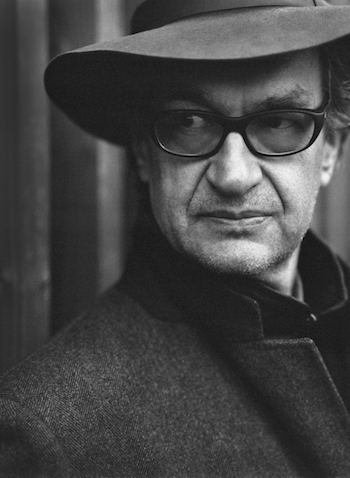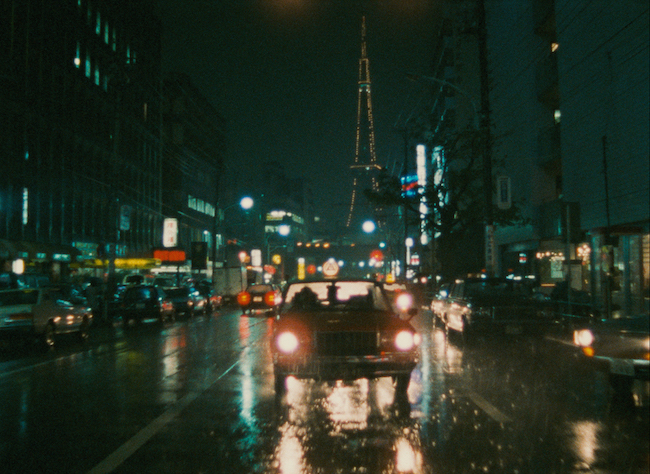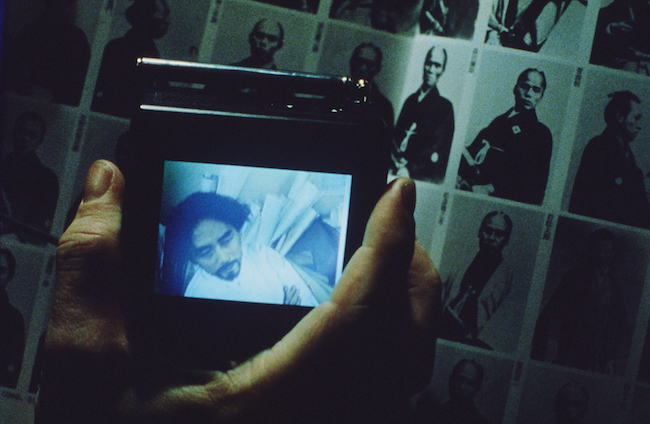Film Interview: Until the End of the Movies—Wim Wenders on his New Retrospective
“Fictional movies seem more and more made from recipes. Documentaries seem a much more open, adventurous field.”

Wim Wenders in 2004. Photo: Donata.
By Peter Keough
In Wim Wenders’s The State of Things (1982), one of the films featured in the traveling retrospective, Wim Wenders: Portraits along the Road, now showing at Cambridge’s Brattle Theatre (through December 13), a German director, not unlike Wenders himself, finds himself stranded on location in Portugal after his American producer betrays him. A thinly veiled version of his own initiation into Hollywood with the benighted noir Hammett (1982), the black and white fable depicts a state of things that has since only gotten worse.
Wenders rebounded from that debacle with such masterpieces as Paris, Texas (1984) and Wings of Desire (1987; screens Friday, December 11), after which Hollywood decided to give him another chance with Until the End of the World (1991; screens Saturday, December 12). Once again, the studio sabotaged his vision, cutting a five-hour apocalyptic epic in half. Consequently, like Hammett, Until the End of the World flopped at the box office.
With this retrospective, audiences will now get an opportunity to see that film as Wenders intended. It also features restored prints of some of the earlier films that established him as one of the leading figures in the New German Cinema of the 1970s, such as Alice in the Cities (1974), Kings of the Road (1976), and The American Friend (1977), and his outstanding documentaries, such as Tokyo-Ga (1985; screens Thursday, December 10 along with Notebooks on Cities and Clothes) and Buena Vista Social Club (1999; screens Sunday, December 13).
Now 70, Wenders discussed the significance of this series, and reflected on the past, present and future of cinema.

Wim Wenders. Photo: Donata
Arts Fuse: You’ve had a number of retrospectives over the years; how is this one different?
Wim Wenders: This one is very special to me because it finally lets people see some of the films that were gone for such a long time. Some of the films from the ’70s were practically unavailable. The Goalie’s Anxiety at the Penalty Kick (1972) was totally unavailable. State of Things was unavailable for 20 years. Alice was in such bad shape that I didn’t want it to be seen anymore. We invested 12 years into restoring 12 of them and now they’re traveling the country. They look like they’re supposed to look. They look like festival prints again. And, of course, we didn’t change any of them because you don’t make changes when you restore, but you try to make them look the way they are intended to be.
Sometimes I feel when you go to a movie theater and you see an old film—like I did the other day when I saw a Rossellini film in an old print with jumps and scratches—and somehow you don’t see it as a film anymore. You see it as a historic relic. But it was not meant to be an artifact; it was once beautiful to watch. So it’s great that my old films look like they did originally and even young audiences can watch them without thinking, “that’s ancient history!”
AF: Is restoring these films kind of like an autobiography?
Wenders: I not only encounter the movies again—some of which I haven’t seen for a long time—but I encounter myself. I wonder who made these movies, because sometimes I’ve forgotten the young man behind them. Sometimes I felt a little bit strange and sometimes I was amazed and sometimes I thought I couldn’t do this again. I wonder how I got that out. I watch not just myself but somebody who I thought I was. I see these old works and realize that some of the things I said when I was 25 or 30 are basically the same things I am saying now. And then I realize that I don’t have an infinite number of stories inside me.
But that also applies to those whom I consider my masters. I have seen all of Ozu’s films, and, in my mind, they’re all one big film, the same story. So you take it for granted that these old masters had one story they were telling in many variations. So when I see one of my old films I realize, hey, this is like an early version of this film. You are telling this story for the fourth time.
Painters and musicians do the same. Authors can’t write a book each time from scratch and reinvent the way they write. As a filmmaker you also can’t reinvent the way you look at the world. Each of these films show how I saw the world then and sometimes it’s not so different from how I see the world today.
AF: Do you think that audiences today can relate to these older movies?
Wenders: At the MoMA retrospective, I was confronted with an audience in which some people had seen them when they first came out and are my age, and some were in their 20s who knew nothing of what I’ve done and this might be the first film of mine they’ve seen. It’s great to talk to these people and realize that sometimes they look at these films as period pieces from a long-lost era and sometimes they look at them like they really still concern them. The beauty of films is that they can remain alive and relevant. Of course it’s not up to the filmmaker to decide that. It’s up to the audience. But some of the talks I had with young people were quite amazing.

A scene from Wim Wenders 1985 documentary “Tokyo-Ga.”—it screens at the Brattle Theatre on December 10.
AF: Which of the films proved most popular?
Wenders: The one film that got the biggest response was my director’s cut of Until the End of the World. When it first came out it was in a totally mutilated, cut-down version. I call it the Reader’s’ Digest version of the film, and only now, 25 years later, I can finally show people what I really meant with this film. What the scope of the ideas and the adventure was. And that’s the film that people reacted to the most.
AF: How did it get chopped up?
Wenders: It was—for an independent auteur movie in 1990—quite extravagant. We shot for one year. It cost $24 million. It was independently produced and, in order to finance it, I had to sign all these contracts, and basically they all insisted that I would deliver a film of no more than two and a half hours.
In the course of the shooting I realized that was going to be pretty impossible. I was shooting around the globe in 10 countries, and then after this physical journey, add a whole other journey into the soul. So when I was shooting the film, I realized I was never going to make this in two and a half hours. And then when I had the version I was most satisfied with, the five-hour version, I tried to convince all the studios—in America it was Warner Bros, but there were also studios and investors in Japan, Europe, Australia—and all the distributors to release it in two parts. But they wouldn’t.
AF: Watching the film 25 years later, it seems rather prescient, anticipating Skype, GPS, suicide bombers, and Google, to name a few. But you did not foresee the demise of pay phones.
Wenders: Ten years from now we will probably smile at what we think of social media today and would think of today as the good old days. We will be much more connected and share each other’s lives 24 hours a day in 10 or 20 years. Surveillance would be total. Poverty would be a much bigger problem than it is today. People migrating would be a much bigger problem. We see right now huge turmoil in Europe with all these fugitives from all over the world arriving, and that’s only the beginning. Ten years from now the whole globe will be covered with people who have to run from one place to the other. More than media developments, if I made such a film today I would try to depict what happens when the gap between rich and poor gets wider.
AF: Would you say that now your filmmaking is more political than it is existential?
Wenders: Yes. I’m making more documentaries. Salt of the Earth (2014) is a much more—in the true sense of the term—down-to-earth film. And I think I’m going to make a film about all these fugitives in Europe.
The older I get the more I’m driven to films that draw on reality rather than fiction. I don’t know why that is. Maybe because fiction nowadays has become so formalized. Fictional movies seem more and more made from recipes. Documentaries seem a much more open, adventurous field. So I think I can do much more these days in documentaries.
AF: Do you think you could still make a fictional feature, like Kings of the Road, without a script? Or is that something you can only do in documentaries?
Wenders: If I go to a producer and say I have a great idea for a movie but I won’t give you a script, they’re going to laugh. In the ’70s when you could make movies like that, you could make films on an experimental basis. But even an established director like myself can’t get a film off the ground without writing it and rewriting it and making a perfect script before getting it financed. With Every Thing Will Be Fine (2015), we had to work on a script for three years. You have to know three months before you make a movie everything that it’s going to be about.

A scene from Wim Wenders 1989 documentary “Notebook on Cities and Clothes.”
AF: That film was in 3D, like your documentary Pina (2011). What is your attraction to this format?
Wenders: I am convinced that this medium can do so much more. It has a capacity that is still untapped. I think it’s a medium that’s ideal for confronting reality and for looking at the world and not just for action and fantasy, which it is mainly used for so far.
It’s a great medium for actors. These 3D cameras can see more than any cameras could before. They see deep into people’s souls. People think I’m crazy to believe this because the present state of 3D movies doesn’t back me up. I hope that auteur filmmakers and documentary filmmakers will jump on it because there is so much more we can do with this medium than blow up the world.
AF: Are you enthusiastic about any other new technology?
Wenders: I think virtual reality is going to be a big in the next few years. Again, it’s going to be exploited for its entertaining capacities, but it also has the possibility to be a serious medium for confronting the world and looking at places. Especially for documentaries. You go into a place and actually look around, see what it’s like in there.
New technologies in movies are, at first, very commercial. Like the first time digital effects were used 10 or 15 years ago, they were very expensive and they were only used in action movies. Nobody thought the digital language was going to save the documentary single handedly. Today there is no documentary that is not partly or totally digital. So a technology that was first used for expensive effects became the medium for documentaries. In a few years, the same will happen with 3D. Every documentary will be made in 3D. And the same will be true for virtual reality as well.
AF: Is your next feature The Beautiful Days of Aranjuez also in 3D?
Wenders: It is. It’s one long dialogue between a man and a woman before the end of the world. So it’s a near-future scenario.
I like to look to the future. More so than looking at the past. I was always enchanted by adventures that took place in the past, but I realized I have more talent for the future.
AF: The future looks dark.
Wenders: Yes, it is dark, but that’s why I like to look into it and imagine ways it might not be so dark after all.
Peter Keough, currently a contributor to The Boston Globe, had been the film editor of The Boston Phoenix from 1989 until its demise in March. He edited Kathryn Bigelow Interviews (University Press of Mississippi, 2013) and is now editing a book on children and movies for Candlewick Press.
